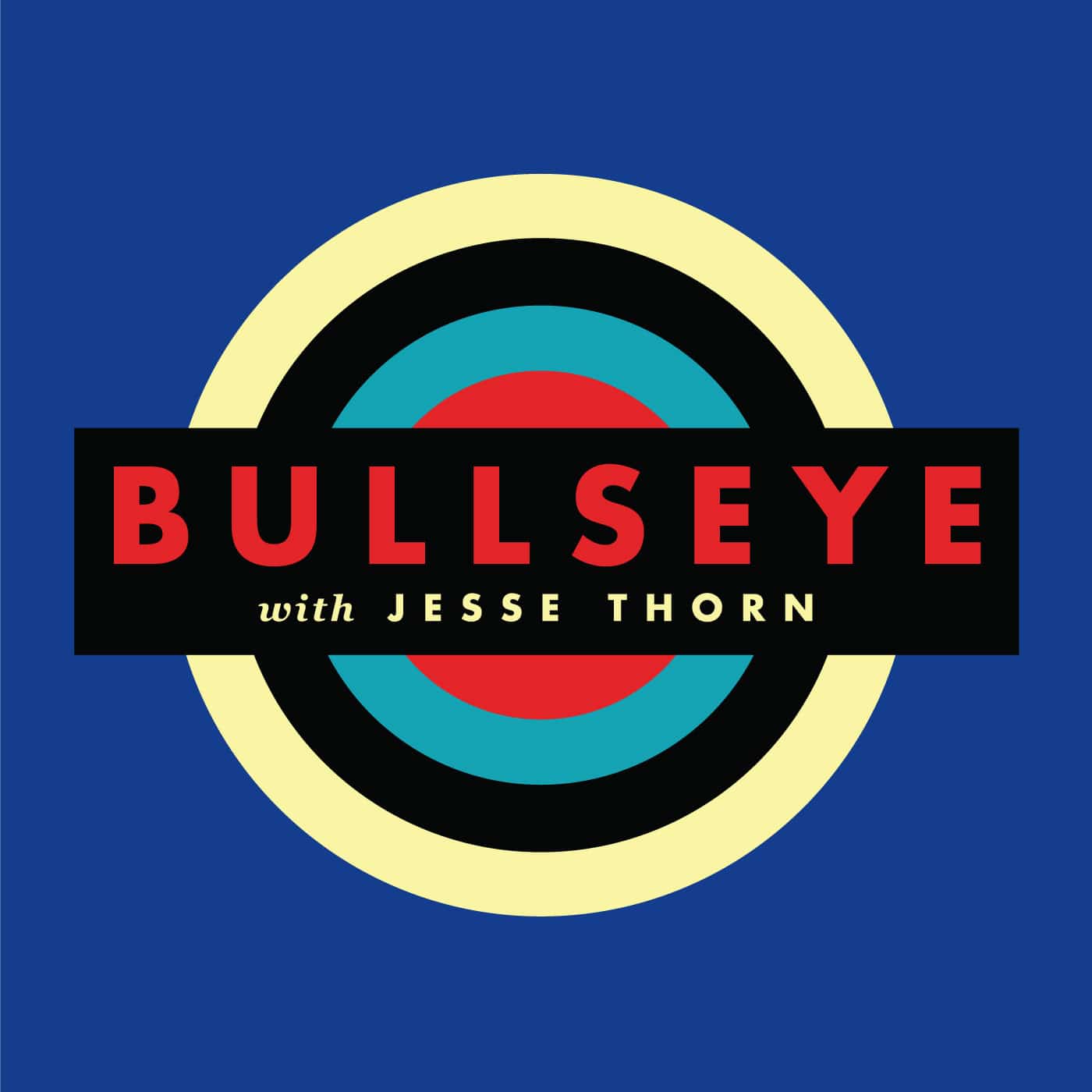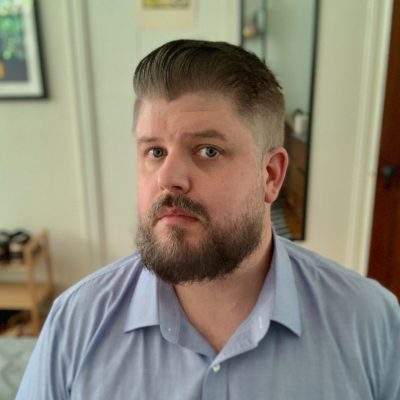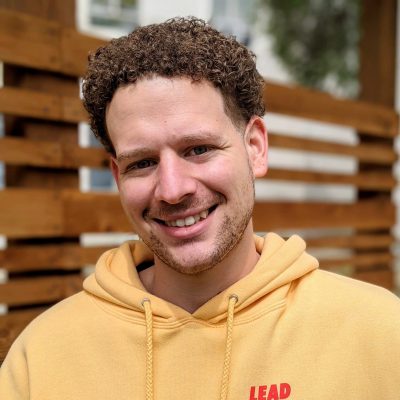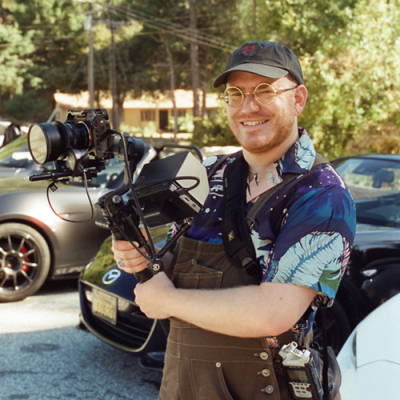Transcript

music
Gentle, trilling music with a steady drumbeat plays under the dialogue.

promo
Speaker: Bullseye with Jesse Thorn is a production of MaximumFun.org and is distributed by NPR. [Music fades out.]

jesse thorn
I’m Jesse Thorn. It’s Bullseye!

music
“Huddle Formation” from the album Thunder, Lightning, Strike by The Go! Team. A fast, upbeat, peppy song. Music plays as Jesse speaks, then fades out.

jesse
Gahan Wilson died this past November, at his home in Scottsdale, Arizona. He as a cartoonist. One of the greatest single-panel cartoonists ever. For decades, his work appeared in The New Yorker and Playboy. And it is impossible to miss—completely distinctive. [Music fades out.] Dark, strange, full of monsters and aliens and pirates. Grotesquery. There’s a kind of perverse joy in laughing at, say, when a guy’s been turned into a giant shrimp and his wife asks if now he’ll finally see a doctor. I talked with Gahan Wilson in 2010—almost a decade ago. I recorded a show in my apartment in Korea Town, here, in Los Angeles. And he breezed through full of absolute vibrance. Even then, he was in his 80’s. [Music fades in.] It’s still one of my favorites. Let’s take a listen.

music
Jazzy music with melodic vocalizations.

jesse
So, I read that you—and you can correct me if I’m wrong—that you got your taste for this kind of… the world of the dark and gory, reading pulp magazines. Is that—is that actually true?

gahan wilson
Well, I think I was there a long time before I got to be old enough to read pulp magazines. I really don’t know when it got started. But I always—I did always like spooky. And that’s—that goes back to when, I—some strange event, I suppose. [Jesse laughs.] And with that said, I just feel sort of cozy with it. I enjoy—just enjoyed it.

jesse
Even like—even as a kid-kid? [Gahan confirms.] Like as a six-year-old or an eight-year-old?

gahan
Yeah, it was—I—Halloween certainly had a good deal to do with it. Halloween, at that—one thing that’s happened, which I find extremely sad, is that Halloween used to be this marvelously unique holiday in that it was strictly under the control of kids. And what would happen, on Halloween, is the kids would put on these costumes or something approximating a costume and get their trick-or-treat apparatus. And then they would leave the house, waving bye-bye to their parents, and go off amongst themselves. Just a bunch of kids. But nowadays, it’s very nice and it is quite dear, and the kids go up—still in costumes and all the rest of it—but they are always accompanied by a grownup. Which is—it is much more sensible and more civically adult and everything else. But it’s wrecked the whole idea of Halloween as a kid’s thing. And so, I associated it—the thing is, part of it—I associate spookiness and that sort of stuff with liberation. [Gahan agrees several times as Jesse speaks.]

jesse
It’s sort of a—it’s sort of a—like a traditional kind of holiday is like a topsy-turvy day. You know and, you know, where the rich man—the poor—the pauper becomes king for a day, or the kids get to do whatever they want and wreak havoc on the adults for a day. It seems like that’s sort of a—that’s—that kind of topsy-turviness has been, in a way, a theme in your work, as well.

gahan
It has, indeed. Yeah. Yeah. And then they sense a sort of a—life is very interesting and sort of odd, mysterious. And that’s a heavy influence. I think it’s a very heavy influence.

jesse
Did you—did you wanna be a cartoonist absolutely, positively, from youth?

gahan
Yeah, from very early on. I… like most of the people I know who… managed to make it in the arts, it’s—you get hit with it quite early. And you become obsessed with it and you just—that’s what you do. I mean, you’re just determined to do it. I can remember—I don’t know exactly how old I was, but I know I was sitting on the carpet and it was obviously Sunday, because I had the Sunday papers. And I had just read the comics section. And… I looked at it and I realized that I wanted to be a cartoonist. I just—it just came to me that that’s what I wanted to do. And that’s it. That—I was doomed, from that time forward. And I had—before then and after then and forever onwards, I was a doodler. I was constantly doodling on things. And everybody that I know that is… that’s been successful in the—in the visual, drawing, painting business is the same way. They’re just compulsive scribblers and scratchers on any kind of paper. Whatever that’s available. And that’s that. It’s… it’s something—it’s something very, I don’t know, just you know, you are. That’s it. You’re that. [Graham agrees several times as Jesse speaks.]

jesse
You were—you were a kid—I’m doing math in my head. You’re in your late 70’s. So, that means that you were a kid—basically your childhood through, you know, age 18 or so—was basically this span of the [laughing] decline and fall of the newspaper comic. The period where it went from this huge part of the newspaper to a very secondary thing. And the birth of comic book. Did—when you were, you know, 17 years old let’s say, and you knew you wanted to be a cartoonist—

crosstalk
Jesse: Did you know what kind you wanted to be? Gahan: Yeah, I—I—yes. Yes, I did.

gahan
I liked the comic strip form. I—then I particularly—I particularly liked Dick Tracy, because the guy who did it—Chester Gould, was his name. Had been—I didn’t know this at that time, but he had been in the Tribune working in the editorial art area, and one of his things he would do, periodically, he would be—they’d ask him to do a map of a crime scene. And then he’d have, you know—it would be this little teeny map and there’d be this “X” and that’s—and it would say, “Jones fell dead here. Foot tracks—bloody footprints went this way.” And so on and so on. And the guy who ran the paper was a guy named Colonel Patterson. And he knew Gould. Gould knew him. And Gould had—he said, yeah he would love to do a comic strip based on this type of detective thing. And they backed him on it, and it was unlike the, sort of, sentimental movie versions that have been made since, it was a—it was a marvelously horrendous thing. You know? [Jesse laughs.] It was really gory stuff. I mean, the villains not only would get shot and—you know, really shot-shot with stuff oozing out of their chest, but the wound would suppurate, you know? And they’d become badly—really badly infected. They might die horribly. [Jesse laughs.] And it was really, really pretty creepy. And so that appealed to me. And I just—but I very… it didn’t—I don’t know exactly when it was, but I shifted over to magazine cartoons as my goal. The New Yorker from the start, particularly. And just—I thought, “That’s it. That’s what I wanna do. That thing. That—comics.” And so, I liked the comic strip form and have been very active in it. That was—that’s what I was going for. [He agrees several times as Jesse talks.]

jesse
With exception, certainly, but The New Yorker cartoon form has a reputation for being somewhat highfalutin. This may be because of the—because of the context in which the cartoons run, but I can’t image that it was that much different in the 1940s and ‘50s than it is, today. What was it that made you think, as a guy who wanted to draw jokes about—you know—creepy [laughs] radiation monsters—think that that was your venue?

gahan
Well, Charlie Adams was—hit at that—very definitely was—I loved his stuff. And so that—he was a great—greatly important. So, I mean, I tended to that for—practically from the beginning. From the get-go. And my first—[stammers] the whole—the cartoon, magazine thing was… it had all—it was—it appeared in all sorts of magazines, including these things, these wonderful magazines which are called pulp magazines. And the pulp magazines would have all kinds of trashy stuff and some of it was very good, actually. But there were several of them that would be—have science fiction themes and spooky themes and so on. And my—when I finally—I went to the Art Institute in Chicago and graduated—took a fine arts course, because I had gone to a commercial school, which is very good, but I wanted to learn technique. And I wanted to learn, really, how to do draw and really how to do it well. And so that was—and I think that was a good decision. And I went to New York and just eked by. Just—and my first sale was to a pulp magazine and it was—I got $7.50 for it, as I recall. And, uh—

jesse
Do you remember what it was?

gahan
Yes! It was a very good cartoon. [Jesse laughs.] It was a—you had—what it was, was a winter scene. You got—it was—snow was falling and all that. And approaching the viewer was a man and his little son. And he had—the father was holding the kid’s hand and the kid was holding his father’s hand and he was looking ahead enthusiastically and pointing and saying, “Look! Daddy, look!” And in the foreground, you saw this dead bird. [Jesse chuckles in surprise.] With its little claws stood poking up towards the sky. And the kid was saying, “Look, Daddy, look! The first robin!” [Jesse laughs.] So, that’s how I got started. So, the whole thing was set, from there. And I never deviated. It was—it—and it worked out.

jesse
There’s a great cartoon in this collection that Playboy and Fantagraphics have just put out, of your complete cartoon for Playboy.

gahan
Yeah, I’m very happy about that.

jesse
A standup comic who’s performing in this kind of post-apocalyptic landscape for, kind of, a handful of bedraggled looking people, saying—saying something like, “Well, I used to do jokes about the end of the world, before the world ended.”

gahan
Yeah. There’s—it’s, you know—it’s—yeah, it’s just, it’s—so that’s—when humor became not just macabre—movie-style macabre—but also macabre politically, and has been, so they—the two intertwined very nicely.

jesse
We’ll finish up with Gahan Wilson when we come back from a quick break. Stay with us. It’s Bullseye, from MaximumFun.org and NPR.

promo
Music: Light, sci-fiesque music. Maddie Sofia: What’s up, nerds? I’m Maddie Sofia, host of Short Wave: the daily science podcast from NPR. We bring you new discoveries, everyday mysteries, and the science behind the headlines. All in about ten minutes. Think of it as a little daily brain snack. And who doesn’t love snacks? You know what I’m saying? Listen and subscribe to Short Wave, from NPR. [Music ends.]

promo
Music: Fun, jaunty, upbeat music. Renee Colvert: Hi! I'm Renee Colvert. Alexis Preston: I'm Alexis Preston! Renee: And we're the hosts of the smash hit podcast Can I Pet Your Dog? Now, Alexis. Alexis: Yes. Renee: We got big news. Alexis: Uh-oh! Renee: Since last we did a promo, our dogs have become famous. Alexis: World-famous! Renee: World—like, stars on the Hollywood Walk of Fame! Second big news. Alexis: Mm-hm? Renee: The reviews are in. Alexis: Mm-hm? Renee: Take yourself to Apple Podcasts, you know what you're gonna hear? We're happy! Alexis: It's true! Renee: We're a delight! A great distraction from the world! Alexis: I like that part a lot. Renee: So, if that's what you guys are looking for... Alexis: Mm-hm. Renee: You gotta check out our show! But what else can they expect? Alexis: We've got dog tech, dog news, celebrities with their dogs. All dog things! Renee: All the dog things. So, if that interests you, well, get yourself on over to Maximum Fun every Tuesday! [Music ends.]

jesse
It’s Bullseye. I’m Jesse Thorn. This week, we’re remembering some folks we lost in 2019. Right now, we’re revisiting my 2010 interview with the great cartoonist, Gahan Wilson. Gahan made brilliant, dark, weird single-panel cartoons in and Playboy for over 50 years. He died this past November. Let’s get back into our conversation. [Gahan agrees several times as Jesse talks.] I read this interview that you did in 1970. And, in this interview, it was an interview—at the time you were living in—with your wife in Key West. And it was—I wanna say the St. Petersburg Times or something like that. It was something I came across on the internet. And this author is talking to you about the different things that you’re interested in. At this point, you’re—I think you’re 39 in this interview. Something like that. And you’re basically pitching this newspaper feature writer from the St. Petersburg Times on R. Crumb. [Laughs.]

gahan
Oh, yeah, yeah.

jesse
You’re trying to tell him why you think that Zapp Comics might be a good thing. What did you think when the world of alternative comics opened up, in the late ‘60s?

gahan
Oh, I was delighted. Because they were doing the same thing that I was doing and it was—I thought, “Well, hooray.” And I—it did have an effect. It was—and huzzah, huzzah. I was—I also got to—one thing that happened, in that period, was that this magnificent publication, The National Lampoon, started. And I wish it was still going on. It ended and now most everybody that was in it is in television or they’re in movies or something. But it was just—it was terrific, because we could just—we were—the—they wanted you to do, is be as rough and tough as you possibly could. They whipped you into more, you know, “Well, why don’t you do this? Why don’t you do that?” And I was happy to do it. I did spreads about all these different themes and didn’t hold back in any of them. And then, a very nice thing happened. I mean, this book—which I’m delighted that’s out now, the Playboy collection—is gonna be followed up with a collection of a thing I did, also for The National Lampoon. Which is a comic strip which was—it’s called Nuts and it was about a—[stammering] I can say the origin of it was they took me aside and they said, “We’re gonna have a little comic book section. It’ll be strip comics, at the end of the book. And we’d like you to be part of it and do a regular, full-page strip each issue. And would you—and something—do something—you know, could you, would you.” And I said, “Oh boy, I’d love to do it.” And I—and they said, “Do you—[stammering] we want you to make it really horrible. Really.” [Jesse laughs.] And I said, “You bet! Okay, yeah!”

crosstalk
Jesse: This is at a time when The National Lampoon was doing some of the most intense satire. Gahan: Oh, it was—yeah. It would just—it would be— Jesse: The satire that we would think of as being very intense, even today. Gahan: Oh, yes. It was— Jesse: 35 years later. Gahan: Yeah. I just—I—it’s a shame it—the thing is not there, because it was—it really did have a effect.

gahan
It was—and it—we need something like that so, so badly. But—so, I started trying—I started to think, “Well, let’s see. Something really horrible. Really horrible.” And I tried to—seeing this and I thought, “No that—” And fell back on, possibly, “Well, let’s see. [Stammering.] I’ll do—yes, monsters. Something like that.” And I just—“Frankenstein time. Dragon? No.” And then I thought, what’s really, really—what was off? What was really hard? What was really scary? And then I thought, “Of course. Being a little kid! That’s it!” You know. And it’s this—it’s this true thing. This—you see—I don’t know what is—I don’t know what was wrong with most grownups, but they seem to think children are these little—happy little things. And they don’t—I don’t know what—have they forgotten everything? Because growing up is a very hard operation. It’s terribly hard. You’ve got this incomprehensible world and you try to make sense out of it, and you try to, you know, take it seriously and it’s just—behaves in this absurd fashion. So, you do the best you can, but—so that was what this Nuts thing was all about. And they’re gonna come out with a collection of—they’re—I had a—there was a book, oh about 10 or 20 years ago, maybe. ’50, I think it was. That had a collection of these Nuts strips, but this one will be the complete Nuts. And that’s—I’m very, very happy. And it’s—it was—that’s what—that’s what it was. It was kids trying to make sense of the world and it was a—it was an effective, as I say so myself, a way of sort of showing how unsensible the world is.

jesse
The title of Nuts—Nuts was a—

gahan
It was a reaction against Peanuts, really. Because—though I think Schulz did a very interesting strip, I don’t think it was about children at all. It was a sort of a… he’s a very religious fellow—was a very religious fellow. And I think it was a bunch of moral fables and these little creatures that he had act out these teachings that weren’t children. They were little figures doing a little thing which told you this or that point, you know? And I was having none of it. [Jesse laughs.] And so, it was just—this is just—so that’s why it was Nuts. But it’s just about—it’s about real little kids and how complicated they—they’re very complicated!

jesse
What were the kinds of experiences that you had, as a kid, that you didn’t see reflected in that precious ideal?

gahan
Well, there’s the sort of thing that everybody has! The bafflement and “Why do my parents act like this?” The “Why do I—why does my father act like this? Why does my mother act like this? Why do they act like this with their neighbors? What is this thing I’m seeing on the television that’s just this bang-bang, boom-boom and all these people getting killed? What is—what is this person doing on the sidewalk crying? Why did this little kid get born blind?” And so on. Tough stuff. And the kids did—the kids are aware of this stuff. And they have to handle it. And the parents have this absurd—they seem to not understand that these kids are extraordinarily perceptive. There’s something—I mean, and if you talk to a little kid, they’re—it’s just eerie. I mean, they really see this stuff. They talk and they’ll—you know, just talk to the little kid like a person. Like it was human being, which it is. And it will open up and it will start telling you these things. And it will say all kinds of things which are amazingly bright and perceptive.

jesse
It seems like one of the things that often marks your cartoons is—is a surprising perspective on something that’s—may or may not be surprising in an of itself, and I was thinking about, you know—thinking about how a kid sees the world as a kid sees the world, rather than as a—as an adult perceives a kid to see the world. [Gahan agrees.] It’s not—it’s not that distant from, you know—you have a lot of cartoons that feature a space alien looking at something.

gahan
Yeah. Yeah. Yeah, exactly. There’s a very definite parallel between—and the… the whole—the whole monster thing is just about, you know—do you have a—do you feel awkward? Are you embarrassed at any point? Do you feel like you don’t fit in, in this particular situation or that particular situation? And so on and so on. I mean, we’re—just, it’s—and a lot of it’s allegory, of course.

jesse
It seems like, in contrast to say Charles Adams—who we talked about, who lived in a very tight form, in his work—

gahan
Yeah. He did—he was—he was absolutely brilliant. And—but his—what he was—what he did, mostly, was to—it was—it wasn’t—it was very little commentary. It was—he took—he came off of the, basically these magnificent movies that James Whale did for Universal—the Karloff Frankenstein and the second Frankenstein and the—Bride of Frankenstein is probably his most incredible movie. And they were not only interestingly scary—very—and sensationally visual things. They were marvelously visual. They were also hilariously funny. They were so—he was—he was—when you do a take-off on Bela Lugosi with these [in an exaggerated accent] Draculaaa, you’re doing—you’re doing a take-off on something which was played very seriously. But with a Frankenstein, it was—it’s—Whale’s Frankenstein was very aware of—it was—it had a lot of humor. [Gahan agrees several times as Jesse talks.]

jesse
At the same time, your work—in contrast to say Adams or Ilica or even, like, another—like an Edward Gorey—other sort of macabre cartoonists. Your work is exploding. Every character has these grotesqueries that, rather than being tight and sharp, are blooming out. You know? Great, festering boils on things and arms stretching too long and, you know, a lot of tentacles. [Laughing.] Heavy on tentacles. How do you think you ended up with this style where things are—where everything seems to be spilling out of itself?

gahan
You know, I like to draw these characters with lots of waddles and all that sort of stuff, too. It’s fun. It’s all—it’s humanity, you know. It’s—we’re bumping along. There is a, also—there is an enormous [stammering] affection in all these things. I do these—I criticize, and I rant and rave in these cartoons because I love people. And I think we’re just wonderful. And I think it’s such a terrible shame that we treat each other so… badly that we hurt each other. And why—we should stop. We, I mean, we’re—there’s many—there’s all kinds of things, in our history, showing how lovely we are. How beautiful. I mean, we produced Bach, we produced Shakespeare. I mean, we are capable of being incredible. And it’s—so let’s do it.

jesse
Are you ever tempted to draw or paint something with the objective being to make it as beautiful as it can be?

gahan
Oh yeah, sure. I’ll—I like to—I paint. Just for myself. But yeah, I love to—yeah. It’s a great—it’s delightful to paint something pretty, yeah.

jesse
How’s—how is that—how is that exercise different than it is to draw—to draw or paint something grotesque, for you?

gahan
It’s a… it’s a—it’s a—it’s a little different, for me, ‘cause I’m just—I’m just relishing how nice it is. And—so I’m just—what I’m doing, there, is I’m just enjoying the moment. [Music fades in.] Loving the moment. Loving the—whatever I’m painting. And… and, as I say, the anger in the cartoons is because—come on, let’s enjoy! Let’s do that! Let’s do that.

music
Relaxing music plays.

jesse
Gahan Wilson. Recorded a decade ago. There are dozens of compilations of Gahan’s work out there. When I talked to him for this interview, Fantagraphics had just published a 50-year retrospective of his work in Playboy. There is so much out and available. You can find them online and in bookstores.

music
Thumpy transition music.

jesse
That’s the end of another episode of Bullseye. Bullseye is produced at MaximumFun.org world headquarters, overlooking MacArthur Park in beautiful Los Angeles, California—where, the other day, Anderson Paak played a concert! Hey! Anderson Paak! Come on Bullseye, please! [Laughs.] We wanna have you. Invitation is open. Show is produced by speaking into microphones. Our producer is Kevin Ferguson. Jesus Ambrosio is our associate producer. We get help from Casey O’Brien and our production fellows are Jordan Kauwling and Melissa Dueñas. Our interstitial music is by Dan Wally, also known as DJW. Our theme song is by The Go! Team. Thanks to them and their label, Memphis Industries, for letting us use it. And we have been doing this show for almost two decades, now. When someone who has been on this show passes away, it’s a reminder that I’ve been doing this a very long time. You can find almost all of our archives on our website, at MaximumFun.org. You can also find many of them in your favorite podcast app or on Facebook or YouTube. One guest who passed away who I really loved talking to—I had him on the show twice—was Harvey Pekar, the creator of the comic American Splendor, which is one of my favorite works of American literature. And Harvey Pekar was everything you would hope you could find in a… grumpy uncle. A wonderful, brilliant man and a great interview subject. I talked to him by phone a couple of times, back when I was producing this show out of Santa Cruz and you can find those interviews on our website, at MaximumFun.org. I think that’s about it. Just remember: all great radio hosts have a signature sign off.

promo
Speaker: Bullseye with Jesse Thorn is a production of MaximumFun.org and is distributed by NPR. [Music fades out.]
About the show
Bullseye is a celebration of the best of arts and culture in public radio form. Host Jesse Thorn sifts the wheat from the chaff to bring you in-depth interviews with the most revered and revolutionary minds in our culture.
Bullseye has been featured in Time, The New York Times, GQ and McSweeney’s, which called it “the kind of show people listen to in a more perfect world.” Since April 2013, the show has been distributed by NPR.
If you would like to pitch a guest for Bullseye, please CLICK HERE. You can also follow Bullseye on Twitter, YouTube, and Facebook. For more about Bullseye and to see a list of stations that carry it, please click here.
Get in touch with the show
People
How to listen
Stream or download episodes directly from our website, or listen via your favorite podcatcher!






